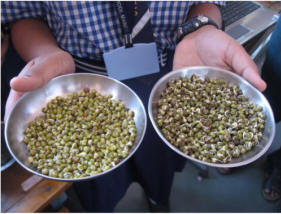|
Earlier we have covered beneficial effects of Agnihotra and Agnihotra Ash on air, soil, and water resources, as well as on radioactive radiation. As environmental pollution naturally also affects plants as it affects us humans, it can be expected that both Agnihotra and Agnihotra Ash have beneficial effects on the growth and health of plants as well as their resistance against pests. The easiest way to experiment about that is by examining the germination of seeds, both in Agnihotra atmosphere and using Agnihotra ash. |
|

|
| Quite a number of such experiments have been done, some of them already quite some time ago. Germination of rice seeds were part of two Ph.D. theses done at the Vivekananda University in Bangalore in the first years of this millenium. Rice seeds were put in petri dishes on top of a filter paper which was soaked in water. Agnihotra was performed, and root length, shoot length, fresh weight, and dry weight were measured and compared with control. There were three controls: One without any disciplines of Agnihotra, one with just the mantras, one with Agnihotra fire but without mantras and offerings. Result was that Agnihotra lead to a significant increase of root length, shoot length, and fresh weight compared to control. Also it was obvious that the effect of Agnihotra is more than the added effects of mantras and the fire alone. Interesting that one study specifically examined whether it makes a difference whether a male person or a female person utters the mantras. No surprise that there was no difference – which hopefully helps to remove one prejudice still prevalent in some countries. The authors attribute the positive effects of Agnihotra on seed germination to the Agnihotra fumes. This seems to be a premature assumption – in experiments on water purification we could show that water gets purified even when the water bottles are closed (and no fumes get into touch with the water). That means there must be some energy field around Agnihotra which leads to this effect. About this Energy Field of Agnihotra we will talk in a later issue of this newsletter. The effect of performing Agnihotra in a room where seeds are kept was subject of these two studies just mentioned. Other studies examined the effect of Agnihotra ash on the germination of seeds. One quite comprehensive study was done a couple of years ago in Fergusson College, Pune, India. Again the seeds were kept on some filter paper in petri dishes. Watering was done with: a) tap water b) control ash water (1 gm control ash + 100 ml water) and c) Agnihotra ash water (1 gm Agnihotra ash + 100 ml water) (Control ash is the ash you get by burning the same ingredients as used for Agnihotra – but without the disciplines of Agnihotra: No mantras, not done at sunrise or sunset, and the vessel – although made from copper – does not have the pyramid shape of our Agnihotra pyramid.) |
|
Seeds of Vigna aconitifolia (mat bean) and Vigna unguiculata (cow pea) were taken as experimental material. Seeds were allowed to germinate and germination was observed every 24 hrs. |
||||
 |
||||
|
||||
|
After getting this encouraging first result, more experiments were done, trying to figure out whether all the different disciplines of Agnihotra are really necessary to get the full effect. For that, variations of the different parameters were used: Fires were done with altogether 48 different combinations of these parameters, and the resulting ashes were used for germination of mung beans, providing same environmental conditions. After two weeks plant growth was measured by considering shoot and root length and put in some graph: |
||||
|
||||
|
Germination of seeds has also been done adding Agnihotra ash / control ash / plain water after the seeds were put into soil (and not just kept on filter paper on petri dishes). Results also clearly showed that Agnihotra ash gives better germination (root length shoot length, total weight) than control ash. Control ash gave better results than plain water which is not surprising as any ash contains certain nutrients. Surprising though is the difference between Agnihotra ash and control ash – as these two ashes do not show a significant difference in chemical analysis! This will be the topic of further discussion. |
||||
|
||||


